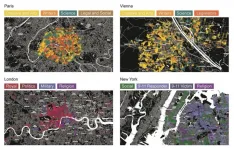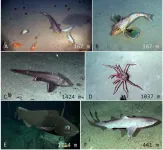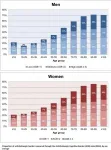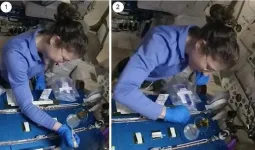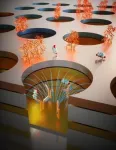NIST-led study finds variations in quantitative MRI scanners' measurements
2021-06-30
(Press-News.org) Magnetic resonance imaging (MRI) is widely used in medicine to detect, diagnose and treat diseases such as cancer, while relying on experts' interpretation of images. Quantitative MRI, which obtains numerical measurements during the scans, can now potentially offer greater accuracy, repeatability and speed -- but rigorous quality control is needed for it to reach its full potential, according to a new study.
Researchers at the National Institute of Standards and Technology (NIST) led the study by 11 institutions comparing measurements by 27 MRI scanners from three vendors at nine clinical sites around the country. To obtain reference values and disentangle sources of bias and variation, the study used a tissue stand-in, or "phantom," originally developed at NIST for evaluating the performance of MRI machines and related software.
MRI uses magnetic fields and radio waves to visualize the body's internal structures, especially soft tissues. Traditional MRI poses several challenges. In addition to subjective image analysis, MRI scanner performance may drift, or different machines may produce contradictory images of the same patient.
Quantitative MRI offers prospects for more consistent disease detection, diagnosis and treatment without the need for tissue biopsy. Ideally, numerical measurements of tumors and other disease markers could be reproduced across many different patients, scanners and clinics over time -- and potentially reduce medical costs. Organizations such as the International Society for Magnetic Resonance in Medicine are promoting quantitative MRI, but it is currently used only in research, not routine patient care.
The new study compared MRI scanner measurements of a value called T1, a property of water molecules that can depend on the surrounding tissue. T1 of the pixels in images is one of the parameters that could be measured by clinical MRI systems. By contrast, subjective interpretations of MRI images look at "T1-weighted" judgments, which are qualitative and nonnumerical.
"A big difference between the T1 and current T1-weighted is that the T1-weighted isn't quantitative," study leader Katy Keenan of NIST said. "The pixel values themselves cannot be compared to pixel values in other datasets. It is not easy to compare T1-weighted data across datasets. In the case of carefully acquired T1, comparison of the pixel values is possible, because they have a quantitative meaning."
The study found that T1 measurements can be subject to significant bias and variation. There was no consistent pattern of discrepancy between vendors, and as a result, a diagnostic threshold value determined on one MRI system can't be transferred to other MRI systems. In some cases, these variations could make a clinical difference in diagnosing a benign versus a malignant brain tumor, seriously affecting patient care, the study found.
As a remedy, the study recommended establishing rigorous quality control procedures for quantitative MRI to promote confidence and stability in measurement techniques and to transfer measurement thresholds for diagnosis, disease progression, and treatment monitoring from research venues to the entire clinical community. The study results echo previous findings by other researchers.
Earlier efforts to use T1 values to categorize brain tumors were impeded by technical inconsistencies and found to be unreliable. But recent advances in quantitative measurement methods have led to improvements in accuracy, repeatability and acquisition speed. The new study is a step toward applying diagnostic threshold T1 measurement across multiple clinical sites.
INFORMATION:
Paper: K.E Keenan, Z. Gimbutas, A. Dienstfrey, K.F. Stupic, M.A. Boss, S.E. Russek, T.L. Chenevert, P.V. Prasad, J. Guo, W.E. Reddick, K.M. Cecil, A. Shukla-Dave, D.A. Nunez, A.S. Konar, M. Liu, S.R. Jambawalikar, L. Schwartz, J. Zheng, P. Hu and E.F. Jackson. Multi-site, multi-platform comparison of MRI T1 measurement using the system phantom. PLOS ONE. June 30, 2021.
[Attachments] See images for this press release:
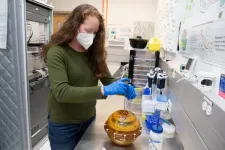
ELSE PRESS RELEASES FROM THIS DATE:
2021-06-30
A city's street names can provide a glimpse into its cultural value system and a way to quantify cultural indicators, according to a study published June 30, 2021 in the open-access journal PLOS ONE by Melanie Bancilhon from Washington University in Saint Louis, U.S., and colleagues.
Ever since named streets have existed, they have been used as a form of social engineering, mirroring a town or city's social, cultural, political, and religious values. Building off this concept in what they term "streetonomics," Bancilhon and colleagues used street names as an alternative route to quantify cultural indicators in four influential Western cities: Paris, Vienna, London, and New York.
The authors used multiple open data sources ...
2021-06-30
The deep sea Pacific Salas y Gómez and Nazca ridges are highly biodiverse and host unique fish and invertebrate taxa, according to video surveys.
INFORMATION:
Article Title: Deep-sea biodiversity at the extremes of the Salas y Gómez and Nazca ridges with implications for conservation
Funding: The expeditions were funded by the National Geographic Society and Pristine Seas donors with support to AMF. Conservation International, the Paul M. Angell Family Foundation, Tom and Currie Barron, and Alan Eustace provided additional support to DW, WG and JG. The Chilean Millennium Science Initiative Program grant #NC120030 ...
2021-06-30
In the German population, a surprisingly high 6% of under-18s are at risk of cognitive decline, falls and more from the cumulative effect of anticholinergic medications such as antihistamines and antidepressants.
INFORMATION:
Article Title: Anticholinergic burden: First comprehensive analysis using claims data shows large variation by age and sex
Funding: The authors received no external funding for this work.
Competing Interests: UH, OR, MB and JR are working at an independent, non-profit research institute, the Leibniz Institute for Prevention Research and Epidemiology - BIPS. Unrelated to this study, BIPS occasionally conducts studies financed by the pharmaceutical industry. Almost exclusively, these are post-authorization ...
2021-06-30
Researchers have developed and successfully demonstrated a novel method for studying how cells repair damaged DNA in space. Sarah Stahl-Rommel of Genes in Space and colleagues present the new technique in the open-access journal PLOS ONE on June 30, 2021.
Damage to an organism's DNA can occur during normal biological processes or as a result of environmental causes, such as UV light. In humans and other animals, damaged DNA can lead to cancer. Fortunately, cells have several different natural strategies by which damaged DNA can be repaired. Astronauts traveling outside of Earth's protective atmosphere face increased risk of DNA damage due to the ionizing radiation ...
2021-06-30
An important function of our vision is to segregate relevant figures from the irrelevant background. When we look at a visual stimulus, it drives a cascade of neural activity from low-level to higher level visual brain areas. The higher areas also provide feedback to the lower areas, where figures elicit more activity than the background, as if figures in the brain are highlighted with extra activity. Researchers from the Netherlands Institute of Neuroscience (NIN) now showed that feedback causes the extra neuronal activity in low-level areas and that the extra activity is essential for figure-ground ...
2021-06-30
MIT engineers and researchers in South Korea have developed a sweat-proof "electronic skin" -- a conformable, sensor-embedded sticky patch that monitors a person's health without malfunctioning or peeling away, even when a wearer is perspiring.
The patch is patterned with artificial sweat ducts, similar to pores in human skin, that the researchers etched through the material's ultrathin layers. The pores perforate the patch in a kirigami-like pattern, similar to that of the Japanese paper-cutting art. The design ensures that sweat can escape through the patch, preventing skin irritation and damage to embedded sensors.
The kirigami design also helps the patch conform to human skin as it stretches and bends. This flexibility, paired with ...
2021-06-30
New Brunswick, N.J. (June 30, 2021) - A Rutgers-led team of researchers has developed a microchip that can measure stress hormones in real time from a drop of blood.
The study appears in the journal Science Advances.
Cortisol and other stress hormones regulate many aspects of our physical and mental health, including sleep quality. High levels of cortisol can result in poor sleep, which increases stress that can contribute to panic attacks, heart attacks and other ailments.
Currently, measuring cortisol takes costly and cumbersome laboratory setups, so the Rutgers-led team looked for a way to monitor its natural fluctuations in daily life and provide patients with feedback that allows them to receive the right treatment at the right ...
2021-06-30
A new study based on computational analyses of how SARS-CoV-2 interacts with host cell proteins has identified 200 previously approved drugs that could be repurposed to treat COVID-19, 40 of which have already entered clinical trials. Furthermore, Namshik Han and colleagues identified 30 proteins induced by the SARS-CoV-2 virus that are targeted by 8 or more existing drugs, finding that nitric oxide production, which is important for viral synthesis, may be targeted by these drugs to fight infection. The researchers also identified 2 of these drugs with good safety profiles that successfully reduced viral replication in cellular assays, suggesting they could potentially prevent or treat COVID-19. Scientists now have sufficient ...
2021-06-30
The Bronze Age in the eastern Mediterranean has long been considered by researchers to have been the 'first international age,' especially the period from 1600-1200 BC, when powerful empires from Anatolia, Mesopotamia, and Egypt set up large networks of subordinate client kingdoms in the Near East. These empires fought, traded, and corresponded with one another, and ancient texts from the period reveal rich economic and social networks that enabled the movement of people and goods.
A new study conducted by an interdisciplinary team of archaeologists, geneticists, and isotope experts, and published in PLOS ONE, investigated the movement of people in this period at a single regional center, a Bronze Age city-state called Alalakh in present-day southeastern Turkey. Their results indicate ...
2021-06-30
University of Leeds news
Embargo: Wednesday 30 June, 7pm GMT
Bereavement care lacking for ethnic minorities
Grieving friends and relatives from ethnic minority backgrounds are suffering from a lack of appropriate help to cope with the loss of a loved one, especially during the COVID-19 pandemic, researchers say.
And the scarcity of data on the services that are available means providers do not know how support should be delivered to ensure they are suitable for different groups of people.
The researchers, led by the University of Leeds and the University of Sheffield, reviewed evidence on UK bereavement care for ethnic minority ...
LAST 30 PRESS RELEASES:
[Press-News.org] NIST-led study finds variations in quantitative MRI scanners' measurements

